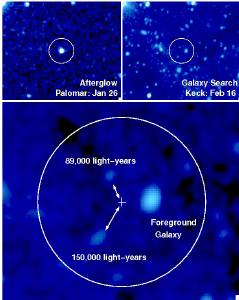http://hpwren.ucsd.edu/news/20071221/
'Shot in the Dark' Star Explosion Stuns Astronomers
By W. Scott Kardel, Public Affairs Coordinator, Palomar Observatory
Last January, NASA's Swift satellite detected another gamma-ray burst and quickly sent its alert to ground-based astronomers. Palomar Observatory's 60-inch telescope was one of the first to respond. The 60-inch, and indeed the entire observatory, is linked into the High Performance Wireless Research and Education Network (HPWREN). HPWREN enabled the message from Swift to be received, allowing the automated 60-inch telescope to quickly measure the fast-fading visible-light afterglow of the GRB. Data was then sent away from Palomar. Measurements prompted observations with the giant 8-meter Gemini North telescope and the 10-meter Keck I telescope. From this astronomers were able to determine the distance to the GRB - 9.4 billion light-years distant. The burst are short lived. Without the rapid transfer of data in and out from Palomar the response to the burst wouldn't be possible.
 |
Measurements indicated that this burst was likely produced by the collapse and explosion of a massive star. These stars "live fast and die young" and are expected to be found in a galaxy where new stars are being produced, yet deep images from Keck failed to find any signs of a galaxy. This means there shouldn't have been that type of star there.
So where did this burst come from? Maybe a faint tidal tail, produced as galaxies collide, is lurking too faint for even Keck to see. Maybe our understanding of this type of GRB is flawed. Deep searches with the Hubble Space Telescope hope to answer the question soon. Stay tuned.
The full story is at: http://www.nasa.gov/centers/goddard/news/topstory/2007/intergalatic_shot.html.

No comments:
Post a Comment